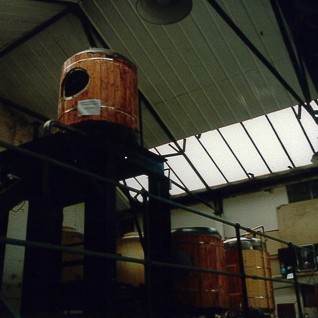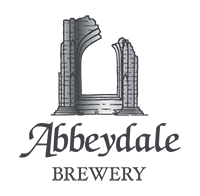Abbeydale Brewery – what came before…

As you will hopefully be aware, here at Abbeydale Brewery we are celebrating our 25th anniversary this year! We’ve come such a long way since 1996… but we wanted to know more about where we came from, how we got here, and what went on before. For that, I would like to hand you over to our brewery founder, co-owner, and the mastermind behind it all – Patrick Morton. The below is in his own words.
“I recall being introduced to the joys of alcoholic fermentation by my father when I was in my mid-teens… somewhere between Reginald Maudling’s legalisation of home brewing and my attaining the significant age of 18.
We had some apple trees in the garden and most years had a reasonable crop of dessert apples to which we would add some Bramleys from the market and feed them all through a primitive, domestic meat mincer clamped to the kitchen table, the resultant slush then being run into a bin containing a few pints of water with a couple of bags of Tate & Lyle and a sachet or two of citric acid (to limit oxidation of the pulp). When all the apples had been processed we would stir in a couple of sachets of “Champagne yeast”. Unsurprisingly ,the fermentation was slow to take off; the apples had been washed in sulphited (Campden Tablets) water and the oxygen content of the must was negligible but we had no understanding of the importance of yeast count at the beginning of fermentation. Nevertheless it always produced an acceptable alcoholic beverage and in some years the tasting depredations (by me and Dad), were sufficiently restrained to leave enough for straining and bottling.
Dad, though, was very much a three or four pints a night man and regarded drink made from fruit as decidedly inferior to “Bitter”. Barbara Castle’s edict of 1967 forced him to re-think his drinking routine, he limited his pub consumption and supplemented it with pint and (I think) 2 pint bottles of Whitbread Pale Ale (often not finished on the night and re-sealed with plastic closures). These were a fabulous source for a somewhat thievish, enthusiastic, teenage beer taster; I still remember the aroma of English hops – probably Fuggles and EKGs. At some point Dad became aware of home brewing and bought a book on the subject, which was actually dreadful, but we didn’t know that at the time. This prompted the start of a few years of brewing “Double Daphne”; it was based on Edme’s 2lb tins of malt extract, diluted and boiled with crystal malt and hops from the home brew shop – 2oz of yellowing hops in a clear plastic bag with a piece of folded cardboard stapled over the top, as often as not hung in the shop window – the hop character of the resulting beer was somewhere on the spectrum from non-existent to unpleasant. Dad found it drinkable but was soon adding sugar to the wort so that the beer was stronger and he didn’t have to drink so much of it. Eventually the combination of the decidedly inferior product, my mother’s impatience with the smell and mess, and our lack of enthusiasm for bottle washing, resulted in home brewing being phased out in the family home.
Eventually, when I was 18, I went to work for my father’s scissors making business (more on that here). As I had a facility for arithmetic I was put to work converting £.s,d to decimal, and other general book-keeping tasks as well as all the manufacturing processes. When I was about 26 I enrolled to study pure and applied mathematics “A” Levels, and the following year I entered Sheffield University as an undergraduate, leaving three years later with a degree in electronics and computer science. I had also gained a fair amount of brewing experience, brewing full mash recipes initially from Dave Line’s books. I quickly found a job as a process control engineer and two weeks later I was in South Carolina commissioning dispensing systems in textile factories. I was doing that and similar work for seven years when, co-incidentally, I was offered the job of brewer at Kelham Island Brewery and took it.
After four and a half years, I decided to leave Kelham Island and start my own brewery. I found an industrial unit on the south side of Sheffield and my father agreed to buy it and rent it to me, as well as enabling me to buy the brewing equipment of Leaking Boot brewery which was closing down. This was basically four old 5 barrel cellar tanks which had been converted into rough approximations of a HLB, a mash tun, a hop back and a copper along with a heat exchanger, cellar cooler, and 80 firkins.
The mash tun referred to was originally a Grundy tank. Leaking Boot Brewery had removed the domed top with an angle grinder, then used the grinder to cut a few dozen slots in the dome to the mash tun floor; it was simply dropped, convex side up, into the remainder of the tank. Its performance was somewhat unsatisfactory; the slots were much too wide and a significant amount of grain passed through to flow into the copper – this is a bad thing – so I obtained some curtain netting from a Sheffield distributor (free because it was to be used in a brewery!) and the first few brews originated from this Heath Robinson horror. Meanwhile I commissioned a new floor from a laser cutting firm near Crystal Peaks, a 3mm stainless steel plate with concentric rings of narrow slots – still far from ideal but a huge improvement on its predecessor.
One of the original Leaking Boot Grundys still serves as a caustic holding vessel in the Conditioning Tank room, another was “stretched” into a 10 Bbl HLB (we wood lined it for insulation, the staves being cut by the joiners who then occupied what is now our brewhouse) and this is still in occasional use on double brew days.
The heat exchanger kept going for over ten years but it became more and more temperamental – it was finally retired when we commissioned the new brewhouse in 2008.
Some of the Leaking Boot firkins may still be in our cask inventory but I imagine most will have disappeared by now, the same applies to the 150 firkins I bought from Wards when they closed in 1999.
Anyway, we got everything set up and that was where it all began – by August 1996, we’d made our first sale (I had to buy a mobile phone as there was no landline), and so Abbeydale Brewery was born.”
We’ll leave it there for now, but there’s much more to tell – we’ll be sharing our stories of our origins, including those of our very first beers (which still form part of our core range today, 25 years later), over the coming few months, so watch this space.
Cheers!




